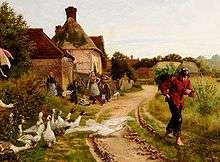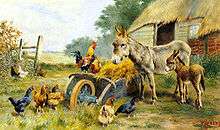Herbert William Weekes
| Herbert William Weekes | |
|---|---|
| Born |
Herbert William Weekes ca. 1842 Pimlico, London, England |
| Died | after 1904 |
| Nationality | English |
| Known for | genre and animal painting |
| Movement | Victorian Neoclassical |
Herbert William Weekes (fl. 1864–1904) was a well-known British genre and animal painter of the Victorian Neoclassical period who specialized in portraying animals in humorous, human-like situations.
Early life and family
Weekes was born ca. 1842 in Pimlico, London, England[1] to a prominent artistic family: the youngest of five children,[2][3] his father, Henry Weekes, Sr. (1807–1877), was a sculptor and Royal Academician;[4] his brother, Henry, Jr. (fl. 1850–1884), was also a genre painter known for his animal studies;[2][5] and his brother, Frederick (1833–1920), was an artist and expert on medieval costume and design.[6]
Later life and career
Weekes appears to have used his middle name, William, for all but formal purposes. He lived and worked for most of his life in London, at 21 Oppidans Road, Primrose Hill.[5][7] In 1865, he married Caroline Anne Henshaw (born ca. 1844), of Hammersmith.[1][8]



Known as an animal and genre painter of the Victorian Neoclassical style, Weekes' work was popular, and helped expand 19th century animal painting from its traditional role of simply recording beasts into a way of reflecting human life.[9][10] He frequently personified animals and placed them in situations particular to humans. His work shows a sensitive understanding of his subject matter, and part of his success in capturing the peaceful country atmosphere depicted in so many of his paintings lay in his affection for it.[11] He was greatly influenced by one of the foremost animal painters of the nineteenth century, Sir Edwin Henry Landseer.[7]
Weekes contributed illustrations for The Illustrated London News in 1883, and exhibited extensively in various London and provincial galleries. His works were well received - although not by everyone: a contemporary wit described his paintings as “Weekes' Weak Squeaks”.[3]
His works were alternatively signed with the initials 'WW' (sometimes overlaid), 'W. Weekes', 'William Weekes', 'Herbert William Weekes', 'H.W. Weekes', 'H. Weekes', and simply 'Weekes'. They were exhibited in a variety of venues from 1864 to 1904, with frequencies as follows:[3]
- Royal Academy (59)
- Walker Art Gallery, Liverpool (15)
- Royal Society of British Artists (10)
- Royal Institute of Oil Painters (8)
- Royal Birmingham Society of Artists (6)
- Arthur Tooth Gallery (3)
- Manchester City Art Gallery (3)
- Royal Glasgow Institute of the Fine Arts (2)
- Fine Art Society (1)
- Grosvenor Gallery (1)
Works
This is an inexhaustive list of Weekes' paintings, primarily done in oil on canvas:
- Acquainted With Whoa
- Anticipation
- An Appeal to the Benevolent
- An Appreciative Audience
- The Avenged
- Backyard Gossip - Two Smooth-Coated Fox Terriers
- Barnyard Friends
- Best of Friends
- The Blockade
- A Captive Audience
- Christmas Greetings
- Cold As Charity
- Congratulations
- Consulting the Oracle
- A Critic
- Court of Arbitration
- Darby and Joan
- Curiosity
- The Disputed Gate
- A Donkey and Geese Beside a Wheelbarrow
- The Eviction
- Farmyard Friends
- Feeding the Pigs (1879)
- A Friendly Gathering
- Fowl Talk
- Fox Terrier (1879)
- A Giant Snowball
- Giving Way
- A Glimpse of the News
- Going to the Dogs
- The Good and the Bad Little Pig (ca.1880, pencil and pen on paper, signed, featuring two pigs in human clothing: a piglet trots down a street playing a flute. A female pig stands beside an upturned apple cart and gesticulates with a stick at the piglet.)
- Good Friends
- Good Taste
- The Grand Procession
- In Great Difficulties
- The Guardian of the Greens
- Guarding the Chicks
- Guilty Conscience
- The Haggle
- How Dare You
- I Smell a Rat
- Kennel Companions (1870)
- The Little Calf
- A Little Girl Feeding Geese
- The Low Comedian's Reception
- Mother and Foal
- Music Hath Charms aka Music To Their Ears
- My Lady's at Home
- Not One of Us
- Outnumbered
- Patience is a virtue
- The Patient and the Quacks
- The Pawnbrokers (1872)
- Peasant Woman in Oval (original title unknown)
- The Pig's Picnic
- Piping the Piggies
- Prattlers and Cracklers
- Pride and Humility
- Quiet!
- The Sermon - A Raven Addressing a Gaggle of Geese
- A Siesta (1906)
- A Snap for the Lot
- A Spaniel Puppy
- Stable Companions
- Street Acrobats (1874, the junction of Regent and Conduit Streets)
- A Stump Oration (a crow lecturing 2 donkeys and geese near a pond)
- Suspicion (ca 1900, a soldier chased by geese through a hamlet)
- A Sweet Thing: Pigs in Bonnets
- Taunting the Geese (ca. 1890)
- Teaching the Puppy New Tricks
- A Terrier
- A Territorial Dispute
- This Comes Hopping You Are Well (1867)
- A Tug o War
- Trespassers
- Two of His Flock (1870s)
- Two Donkeys and a Carrion Crow (original title unknown)
- The Unruly Mob
- The Unruly Neighbors
- Unwelcome Guest
- An Unusual Visitor
- An Urban Council
- A Visitor
- Waiting Is a Virtue
- Washer Woman and Two Dandies (original title unknown)
- A Watchful Eye
- A Wee Bit Frightened
- Where Are They
- Which Way to Market
- Which Way to Cork
- You Are Sitting in My Nest
References
- 1 2 "IGI Individual Record: Herbert Weekes". FamilySearch.org. 14 Oct 1865. Retrieved 29 Jan 2009.
- 1 2 "The Little Calf, Henry Weekes, Jnr., fl: 1850–1884". J. Collins & Son Fine Art. Retrieved 28 Jan 2009.
- 1 2 3 "Quiet!, Herbert William Weekes fl: 1864–1904". J. Collins & Son Fine Art. Retrieved 2008-03-18.
- ↑ "Weekes, Henry (English sculptor and teacher, 1807–1877)". Getty Museum. Retrieved 2008-03-17.
- 1 2 "Artist Biography: William Weekes fl. 1864–1904". Burlington Paintings. Retrieved 2009-01-29.
- ↑ "Autumn Exhibition: Frederick Weekes (1833–1920)". Michael Sim. Retrieved 2008-03-18.
- 1 2 "Two of His Flock". Invaluable.com. Retrieved 29 Jan 2009.
- ↑ "FamilySearch International Genealogical Index". FamilySearch.org. 1881. Retrieved 29 Jan 2009.
- ↑ "Herbert William Weekes Biography". Haynes Fine Art of Broadway. Archived from the original on 2008-02-16. Retrieved 28 Jan 2009.
- ↑ "Herbert William Weekes". Artnet. Retrieved 28 Jan 2009.
- ↑ "Suspicion". Cinoa. Retrieved 13 Jul 2009.
External links
|